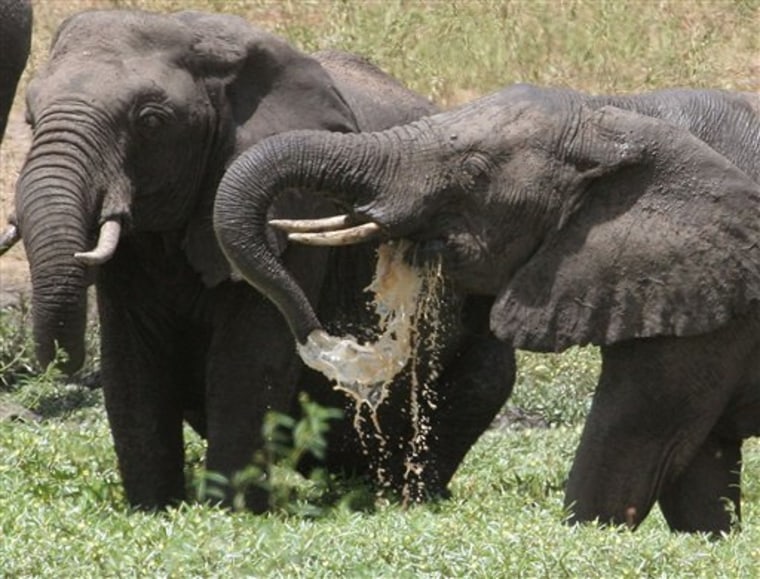Fundisile, a majestic male elephant, ambled through the dense bush to the waterhole, extending his trunk in greeting to two young females, April and Aqua, their mother Aran and grandmother Agatha.
The captivating scene illustrated South Africa's success in catapulting its herds from virtual extinction to population explosion — but also highlighted the resulting dilemma of how to prevent the world's mightiest mammal from wreaking havoc on more delicate animal and plant species.
Environment Minister Marthinus van Schalkwyk said Wednesday that authorities might have to resume killing elephants — ended in 1995 under international pressure — as part of a package of measures including contraception and relocation to slow the rampant growth in numbers. The idea of killing elephants in South Africa is especially striking given that elephant populations in other countries are low, and that, globally, the elephant is classed as "vulnerable" and trade in ivory has been banned since 1989 to try to combat poaching.
"The government will never give a blank check to culling," van Schalkwyk said, but said it had to preserve the delicate balance of nature in the flagship Kruger National Park and other wildlife reserves.
"We have about 20,000 elephants in South Africa, more or less 14,000 in the Kruger National Park. In 1995 when we stopped culling we had around 8,000 elephants. The population growth of elephants is 6 to 7 percent," Van Schalkwyk said.
"This is the hard reality," he told a press conference overlooking a watering hole in Addo Elephant Park, where the elephant population is set to double by 2020 — as is the population in Kruger.
Seeking ecosystem balance
Although this is good news for the tourists hoping to spot the Big Five — elephant, rhino, lion, leopard, buffalo — it is inflicting a heavy toll on vegetation and other animal species.
A single elephant devours up to 660 pounds of grass, leaves and twigs a day.
Van Schalkwyk said the elephant management proposals included moving them to other areas, creating special enclosures to protect other species, expanding parks, contraception and shooting selected animals.
"I would have preferred not to consider the options of both culling and contraception," he said.
Interested parties have until May 4 to comment and then after that it may take many more months to bring the measures into force.
The initial reaction was positive.
The World Wildlife Fund said it recognized the problem posed by elephant overpopulation and hailed the government for consulting with conservation groups.
"Although WWF does not advocate culling as the preferred management alternative, we recognize that it is a management option and reiterate our view that all other options should first be explored," said Rob Little, acting chief executive of WWF South Africa.
The International Fund for Animal Welfare welcomed the promise by the minister to invest more into scientific research.
"We dearly hope this indicates a long-term intention to ensure an ethical approach to elephant management," it said.
There are still vivid memories of elephants being shot in a 1967-1994 campaign in which 14,562 were killed — without that their numbers would have rocketed by now to 80,000, according to national park estimates.
Van Schalkwyk declined to predict how many elephants might die if culling does get the final green light.
Contraception not easy solution
Although contraception is an alternative, it is also fraught with problems. A female normally breeds every four years and doesn't mate while nursing. With contraception, a female comes on heat every four months — but doesn't fall pregnant — and so suffers the physical stress of frequent copulation with bulls four times her weight.
Moving elephants to different areas is expensive. Conservation experts say there are signs that elephants are beginning to move from the Kruger into Mozambique, where populations are more sparse because of the long civil war, thanks to the removal of national fences in a new trans-frontier park. But space is limited.
South Africa, Namibia and Botswana all have booming elephant populations, while East and West African nations are struggling.
Some African countries have called for the right to resume controlled sales of ivory, saying the proceeds can benefit local populations and help pay for conservation efforts. But Kenya and Mali are seeking a 20-year ban on all trade in raw or worked ivory.
Most ivory comes from the much larger populations of African elephants — even Asian countries import African ivory. The Asian elephant — smaller than its African counterpart — is classed as "endangered," by the International Union for the Conservation of Nature. Encroachment on its natural habitat by humans has slashed the population to an estimated 30,000-50,000 animals in the wild in countries like Thailand, Vietnam and Myanmar.
African countries, too, faced extinction of their elephant populations. South Africa had just 200 elephants at the turn of the century.
Botswana has by far the biggest elephant population, with an estimated 165,000 elephants, according to van Schalkwyk. He said Zimbabwe had an estimated 80,000 and Mozambique some 20,000.
In Addo, the elephants feed on 146 different plant species — of which 75 are classed as rare, he said. Addo is about an hour's drive from the southern coastal city of Port Elizabeth.
Authorities have reintroduced the endangered black rhino into the park, where it lives in harmony with the elephant, but fear they could start competing for food.
Already, the crowding is leading to tensions, according to Graham Kerley, an elephant expert who works with officials at Addo National Park, which currently has some 450 elephants. The females live to about 65 years old, but fighting among the bulls has reduced their average life span to 45 years — not long enough for them to grow the mighty tusks that are the trademark of other South African elephant populations.
